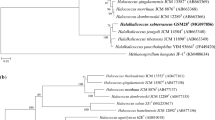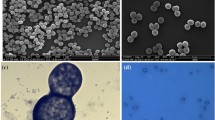Abstract
A novel thermoacidophilic archaeal strain has been isolated from three geothermal acidic hot springs in Copahue, Argentina. One of the most striking characteristic of ALE1 isolate is its metabolic versatility. It grows on sulphur, tetrathionate, iron (II) and sucrose under aerobic conditions, but it can also develop under anaerobic conditions using iron (III) or sulphur as electron acceptors and sulphur or hydrogen as electron donors autotrophically. A temperature of 75 °C and a pH between 2.5 and 3.0 are strain ALE1 optimal growth conditions, but it is able to oxidise iron (II) even at pH 1.0. Cells are irregular cocci surrounded by a regularly arrayed glycoprotein layer (S-layer). Phylogenetic analysis shows that strain ALE1 belongs to the family Sulfolobaceae in the class Thermoprotei, within the phylum Crenarchaeota. Based on 16S rRNA gene sequence similarity on NCBI database, ALE1 does not have closely related relatives, neither in culture nor uncultured, which is more surprising. Its closest related species are strains of Acidianus hospitalis (91 % of sequence similarity), Acidianus infernus (90 %), Acidianus ambivalens (90 %) and Acidianus manzanensis (90 %). Its DNA base composition of 34.5 % mol C + G is higher than that reported for other Acidianus species. Considering physiological and phylogenetic characteristics of strain ALE1, we considered it to represent a novel species of the genus Acidianus (candidatus “Acidianus copahuensis”). The aim of this study is to physiologically characterise this novel archaea in order to understand its role in iron and sulphur geochemical cycles in the Copahue geothermal area and to evaluate its potential applications in bioleaching and biooxidation.






Similar content being viewed by others
References
Achenbach L, Woese C (1995) 16S and 23S rRNA-like primers. In: Sower KR, Schreier HJ (eds) Archaea: a laboratory manual. Cold Spring Harbor Laboratory, Cold Spring Harbor, pp 521–523
Brock TD, Brock KM, Belly RT, Weiss RL (1972) Sulfolobus: a new genus of sulfur oxidising bacteria living at low pH and high temperature. Arch Microbiol 84:54–68
Chiacchiarini P, Lavalle L, Giaveno A, Donati E (2009) Acidophilic microorganisms from geothermal Copahue Volcano system. Assessment of biotechnological applications. Adv Mater Res 71–73:87–91
Chiacchiarini P, Lavalle L, Giaveno A, Donati E (2010) First assessment of acidophilic microorganisms from geothermal Copahue–Caviahue system. Hydrometallurgy 104:334–341
Delpino DH (2009) Naturally acid Waters from Copahue volcano, Argentina. Appl Geochem 24:208–220
Deming JW, Baross JA (1986) Solid medium for culturing black smoker bacteria at temperatures to 120 °C. Appl Environ Microbiol 51:238–243
Ehrlich HL (2002) Geomicrobiology, 4th edn. Marcel Dekker Inc, New York
Felsenstein J (1985) Confidence limits on phylogenies: an approach using the bootstrap. Evolution 30:783–791
Folguera A, Ramos V (2000) Control estructural del volcán Copahue (38° S–71° O): implicancias tectónicas para el arco volcánico cuaternario (36–39° S). Rev Asoc Geol Argent 55:229–244
Fuchs T, Huber H, Burggraf S, Stetter KO (1996) 16S rDNA-based phylogeny of the archaeal order Sulfolobales and reclassification of Desulfurolobus ambivalens as Acidianus ambivalens comb. nov. Syst Appl Microbiol 1:1956–1960
González Díaz EF (2005) Geomorfología de la región del volcán Copahue y sus adyacencias (centro-oeste del Neuquén). Rev Asoc Geol Argent 60:72–87
He Z, Zhong H, Li Y (2004) Acidianus tengchongensis sp. nov., a new species of acidothermophilic archaeon isolated from an acidothermal spring. Curr Microbiol 48:159–163
Johnson DB, Jameson E, Rowe OF, Wakeman K, Hallberg KB (2009) Sulfidogenesis at low pH by acidophilic bacteria and its potential for the selective recovery of transition metals from mine water. Adv Mater Res 71–73:693–696
Kimura M (1980) A simple method for estimating evolutionary rates of base substitution through comparative studies of nucleotide sequence. J Mol Evol 16:111–120
Kletzin A (2008) Oxidation of sulfur and inorganic sulfur compounds in Acidianus ambivalens. In: Dahl C, Fredrich GC (eds) Microbial sulfur metabolism. Springer, Berlin, pp 184–200
Krepski ST, Hanson TE, Chan CS (2012) Isolation and characterization of a novel biomineral stalk-forming iron-oxidizing bacterium from a circumneutral groundwater seep. Environ Microbiol 14:1671–1680
Liang CL, Xia JL, Nie ZY, Yang Y, Ma CY (2012) Effect of sodium chloride on sulfur speciation of chalcopyrite bioleached by the extreme thermophile Acidianus manzaensis. Biores Technol 110:462–467
Lin CC, Casida LE Jr (1984) Gerlerite as a gelling agent in media for the growth of thermophilic microorganisms. Appl Environ Microbiol 47:427–429
Lindstrom BE, Sehlin HM (1989) High efficiency of plating of the thermophilic sulfur-dependent archaebacterium Sulfolobus acidocaldarius. Appl Environ Microbiol 55:3020–3021
Mardanov AV, Gumerov VM, Beletsky AV, Perevalova AA, Karpov GA, Bonch-Osmolovskaya EA, Ravin NV (2011) Uncultured archaea dominate in the thermal groundwater of Uzon Caldera, Kamchatka. Extrem 15:365–372
Mas G, Mas L, Bengochea L (1996) Alteración ácido-sulfática en el campo geotérmico Copahue, Provincia de Neuquén. Rev Asoc Geol Argent 51:78–86
Monasterio AM (2008) Termas de Copahue. Balnea 4:151–163
Ochsenreiter T, Drazenka S, Quaiser A, Bonch-Osmolovskaya L, Scleper C (2003) Diversity and abundance of Crenarchaeota in terrestrial habitats studied by 16S RNA surveys and real time PCR. Environ Microbiol 5:787–797
Pachiadaki MG, Lykousis V, Stefanou EG, Kormas KA (2010) Prokaryotic community structure and diversity in the sediments of an active submarine mud volcano (Kazan mud volcano, East Mediterranean Sea). FEMS Microbiol Ecol 72:429–444
Plumb J, Haddad CM, Gibson JA, Franzmann PD (2007) Acidianus sulfidivorans sp. nov., an extremely acidophilic, thermophilic archaeon isolated from a solfatara on Lihir Island, Papua New Guinea, and emendation of the genus description. Int J Syst Evol Microbiol 57:1418–1423
Rawlings DE (1995) Restriction enzyme analysis of 16S rRNA genes for the rapid identification of Thiobacillus ferrooxidans, Thiobacillus thiooxidans and Leptospirillum ferrooxidans strains in leaching environments. In: Jerez JCA, Vargas T, Toledo H, Wiertz JV (eds) Proceedings of the International Biohydrometallurgy Symposium, IBS-95, vol.1. University of Chile, Santiago de Chile, pp 343–350
Roth V (2006) http://www.doubling-time.com/compute.php
Saitou N, Nei M (1987) The neighbor-joining method: a new method for reconstruction of phylogenetic trees. Molec Biol Evol 4:406–425
Segerer A, Neuner AM, Kristjansson JK, Stetter K (1986) Acidianus infernus gen. nov. sp. nov. and Acidianus brierleyi comb. nov.: facultatively aerobic, extremely acidophilic thermophilic sulfur-metabolizing archaebacteria. Int J Syst Bacteriol 36:559–564
Sleytr UB, Beveridge TJ (1999) Bacterial S-layers. Trends Microbiol 6:253–260
Tamura K, Peterson D, Peterson NJ, Nei M, Kumar S (2011) MEGA5: molecular evolutionary genetics analysis using maximum likelihood, evolutionary distance, and maximum parsimony methods. Mol Biol Evol 28:2731–2739
Taniuchi Y, Chen YL, Chen HY, Tsai ML, Ohki K (2012) Isolation and characterization of the unicellular diazotrophic cyanobacterium Group C TW3 from the tropical western Pacific Ocean. Environ Microbiol 14:641–654
Tupikina OV, Ngoma IE, Minnaar S, Harrison STL (2011) Some aspects of the effect of pH and acid stress in heap bioleaching. Miner Eng 24:1209–1214
Urbieta MS, González Toril E, Aguilera A, Giaveno MA, Donati E (2012) First prokaryotic biodiversity assessment using molecular techniques of an acidic river in Neuquén, Argentina. Microb Ecol 64:91–104
Varekamp D, Maartende Moor J, Merrill M, Colvin A, Goss A, Vroon P (2006) Geochemistry and isotopic characteristics of the Caviahue–Copahue volcanic complex, Province of Neuquen, Argentina. Geol Soc Am Spec Pap 407:317–342
Yoshida N, Nakasato M, Ohmura N, Ando A, Saiki H, Ishii M (2006) Acidianus manzaensis sp.nov., a novel thermoociphic archaeon growing authophically by the oxidation of H2 with the reduction of Fe3+. Curr Microbiol 53:406–411
Acknowledgments
The authors especially thank to Dr. Wolfgang Sand who kindly allowed the use of AFM to get the images shown in Fig. 1. MINCYT-BMBF funded a fellowship for M.A. Giaveno. This work was partially supported by grants ANPCyT (PICT 0749), CONICET (PIP 0368), Universidad Nacional del Comahue and Universidad Nacional de La Plata.
Author information
Authors and Affiliations
Corresponding author
Rights and permissions
About this article
Cite this article
Giaveno, M.A., Urbieta, M.S., Ulloa, J.R. et al. Physiologic Versatility and Growth Flexibility as the Main Characteristics of a Novel Thermoacidophilic Acidianus Strain Isolated from Copahue Geothermal Area in Argentina. Microb Ecol 65, 336–346 (2013). https://doi.org/10.1007/s00248-012-0129-4
Received:
Accepted:
Published:
Issue Date:
DOI: https://doi.org/10.1007/s00248-012-0129-4




